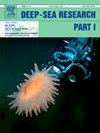Sedimentary, geochemical and reservoir characteristics of the Quaternary submarine fan in the Qiongdongnan basin
IF 2.3
3区 地球科学
Q2 OCEANOGRAPHY
Deep-Sea Research Part I-Oceanographic Research Papers
Pub Date : 2025-01-01
DOI:10.1016/j.dsr.2024.104429
引用次数: 0
Abstract
The South China Sea holds significant marine oil and gas resources, with the Qiongdongnan Basin being a key area. Submarine fans, as major marine reservoir systems, are crucial for storing natural gas and gas hydrates. However, research on the large Quaternary submarine fan in this basin is limited. Our study examines the importance of Quaternary submarine fans in the Qiongdongnan Basin, South China Sea, with a focus on their development. By utilizing 3D seismic data and core samples, our research aims to analyze submarine fan features and their developmental processes. The submarine fans are divided into four units, with Unit 1–2 submarine fans and internal waterways gradually increasing in size, and Unit 2 to Unit 4 submarine fans and waterway development decreasing in size. Through major and trace element analysis of core samples, we discovered that each major and trace element has different characteristics in different units, such as higher relative contents of Zr and Ti in Units 3 and 4, and higher relative contents of K in Unit 2. Simultaneously microscopic observations and reservoir characteristic parameters are utilized to evaluate the quality of submarine fan reservoirs. We reveal that Unit 2 has the best reservoir quality, followed by Unit 1, and that Units 3 and 4 have poor reservoirs quality This research enhances understanding of the sedimentary evolution of submarine fans in the Qiongdongnan Basin, offers insights into regional geological processes and contributes to global deep-water basin exploration and management.
琼东南盆地第四纪海底扇沉积、地球化学及储层特征
南海蕴藏着重要的海洋油气资源,琼东南盆地是南海油气资源的重要区域。海底扇作为主要的海洋储层系统,对天然气和天然气水合物的储存至关重要。然而,对该盆地第四纪大型海底扇的研究较为有限。本研究探讨了南海琼东南盆地第四纪海底扇的重要性,并重点研究了其发育情况。利用三维地震资料和岩心样品,分析海底扇的特征及其发育过程。潜艇风机分为4个单元,1-2单元潜艇风机和内部水道的尺寸逐渐增大,2 - 4单元潜艇风机和水道的尺寸逐渐减小。通过对岩心样品的量微量元素分析,我们发现不同单元的各量微量元素具有不同的特征,如单元3和单元4中Zr和Ti的相对含量较高,单元2中K的相对含量较高。同时利用微观观测和储层特征参数对海底扇储层进行了质量评价。研究结果表明,2单元储层质量最好,1单元次之,3、4单元储层质量较差。该研究加深了对琼东南盆地海底扇沉积演化的认识,有助于了解区域地质过程,为全球深水盆地勘探与管理提供依据。
本文章由计算机程序翻译,如有差异,请以英文原文为准。
求助全文
约1分钟内获得全文
求助全文
来源期刊
CiteScore
4.60
自引率
4.20%
发文量
144
审稿时长
18.3 weeks
期刊介绍:
Deep-Sea Research Part I: Oceanographic Research Papers is devoted to the publication of the results of original scientific research, including theoretical work of evident oceanographic applicability; and the solution of instrumental or methodological problems with evidence of successful use. The journal is distinguished by its interdisciplinary nature and its breadth, covering the geological, physical, chemical and biological aspects of the ocean and its boundaries with the sea floor and the atmosphere. In addition to regular "Research Papers" and "Instruments and Methods" papers, briefer communications may be published as "Notes". Supplemental matter, such as extensive data tables or graphs and multimedia content, may be published as electronic appendices.

 求助内容:
求助内容: 应助结果提醒方式:
应助结果提醒方式:


